
Anoka is a city in, and the county seat of, Anoka County, Minnesota. The population was 17,142 at the 2010 census. Anoka is the "Halloween Capital of the World", because it hosted one of the first Halloween parades in 1920. It continues to celebrate the holiday each year with several parades. Anoka is a northern suburb of the Twin Cities. U.S. Highways 10 / 169 and State Highway 47 are three of Anoka's main routes, and it has a station on the Northstar Commuter Rail line to Minneapolis.

Interlochen Center for the Arts is a tax exempt, 501(c)(3) non-profit corporation, operating an arts education institution in northwest Michigan. The center is situated on a 1,200-acre (490 ha) campus in Interlochen, Michigan, roughly 15 miles (24 km) southwest of Traverse City. Interlochen draws young people from around the world to study music, theater, dance, visual arts, creative writing, motion picture arts, and comparative arts. Interlochen Center for the Arts is the umbrella organization for Interlochen Arts Camp, Interlochen Arts Academy boarding high school, Interlochen Public Radio, and the "Interlochen Presents" performing arts series. The Interlochen College of Creative Arts is an affiliated but separate non-profit corporation.

Split Rock Lighthouse is a lighthouse located southwest of Silver Bay, Minnesota, USA on the North Shore of Lake Superior. The structure was designed by lighthouse engineer Ralph Russell Tinkham and was completed in 1910 by the United States Lighthouse Service at a cost of $75,000, including the buildings and the land. It is considered one of the most picturesque lighthouses in the United States.

The William Randolph Hearst Greek Theatre, known locally as simply the Greek Theatre, is an 8,500-seat amphitheater owned and operated by the University of California, Berkeley in Berkeley, California, USA.
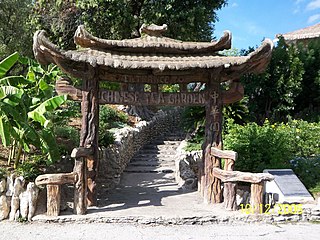
The San Antonio Japanese Tea Garden, or Sunken Gardens in Brackenridge Park, San Antonio, Texas, USA opened in an abandoned limestone rock quarry in the early 20th century. It was known also as Chinese Tea Gardens, Chinese Tea Garden Gate, Chinese Sunken Garden Gate and is listed on the U.S. National Register of Historic Places.

The Anoka–Champlin Mississippi River Bridge, also known as the Ferry Street Bridge, is a 10-span open spandrel concrete deck arch bridge that spans the Mississippi River between Anoka and Champlin, Minnesota, United States. It was built in 1929 by the Minneapolis Bridge Company, replacing an 1884 bridge at the same site.
Purcell & Elmslie (P&E), as it was most widely known, was a progressive American architectural practice. P&E was the second most commissioned firm of the Prairie School, after Frank Lloyd Wright. The firm was active from 1917 to 1921.
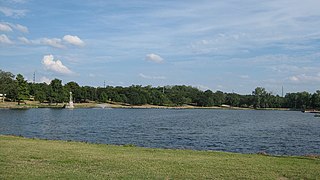
The Wintersmith Park Historic District, known locally as simply Wintersmith Park, is a historic district located at 18th Street and Scenic Drive in Ada, Oklahoma. The park includes a lake, a lodge, bridges, trails, courts and a public amphitheater. The area is listed in the National Register of Historic Places. The park is named for Frances Wintersmith.
Joseph Edgar Maddy was a pioneering American music educator and conductor.

Georgetown College Historic Buildings are a group of historically significant building located on the campus of Georgetown College in Scott County, Kentucky. The structures were added to the U.S. National Register of Historic Places in 1979.
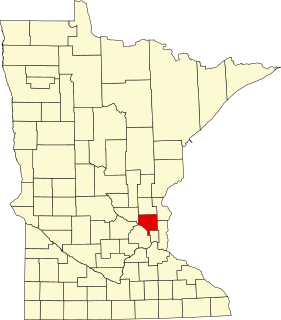
This is a list of the National Register of Historic Places listings in Anoka County, Minnesota. It is intended to be a complete list of the properties and districts on the National Register of Historic Places in Anoka County, Minnesota, United States. The locations of National Register properties and districts for which the latitude and longitude coordinates are included below, may be seen in an online map.

The Greek Amphitheatre is an open-air amphitheater on the campus of Southern Arkansas University (SAU) in Magnolia, Arkansas. Located at the southeastern corner of the campus, it is the only performance space of its kind in southern Arkansas, and has regularly been the site of university events. It was built in 1938 by a combined effort of the National Youth Administration, and New Deal works program, and the 1936 graduating class of Magnolia A & M, as SAU was then called. It has a seating area 103 feet (31 m) wide and about 83 feet (25 m) deep. All of its major elements, including the seating area and stage, are made of concrete.

The Foster Park Bowl is an outdoor amphitheatre located between Ojai and Ventura, California. Built in 1928, it has a seating capacity of 1,000.

Crescent Grange Hall #512 is a former meeting hall of the Grange agricultural society in Lindwood Township, Minnesota, United States. It was built from 1881 to 1882 by a chapter of the State Grange of Minnesota, the first state-level subdivision of the National Grange. It was listed on the National Register of Historic Places in 1979 for its local significance in the themes of agriculture and social history. It was nominated for being a well preserved example of an early meeting hall built by a subordinate Grange.

The Anoka Post Office is a former post office building in Anoka, Minnesota, United States. It was built in 1916 in a Colonial Revival design credited to architect James Knox Taylor. It remained in service as a U.S. Post Office until 1977, after which it has housed a variety of commercial tenants. The building was listed on the National Register of Historic Places in 1979 for its local significance in the theme of architecture. It was nominated for its status as Anoka's oldest surviving public building and most architecturally significant non-residential property.

The Banfill Tavern, also known as the Locke House, is a historic building in Fridley, Minnesota, United States. It was built in 1847 on the east bank of the Mississippi River and has served variously as an inn, a logging camp office, a private home, a dairy farm, a post office, and a summer home. It is now owned by Anoka County and houses the non-profit Banfill-Locke Center for the Arts. The building stands within Manomin County Park, and the art center is a partner site of the Mississippi National River and Recreation Area.

The Ogilvie Watertower is a historic water tower in Ogilvie, Minnesota, United States, built in 1918. It was listed on the National Register of Historic Places in 1980 for having local significance in the themes of engineering and social history. It was nominated for being a rare surviving example of Minnesota's earliest reinforced concrete water towers and a symbol of the local infrastructure improvements that enabled the organization of Ogilvie's fire department.

The Shaw–Hammons House, also known as the DeGraff–Follrath House, is the oldest standing residential building in Anoka, Minnesota, United States. It was originally built around 1852 and then expanded in 1870. The Shaw–Hammons House was listed on the National Register of Historic Places in 1979 for its local significance in the themes of architecture and exploration/settlement. It was nominated for its association with local Euro-American settlement through its succession of notable early owners, and for being Anoka's best-preserved example of Greek Revival architecture.
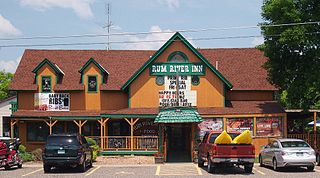
The Riverside Hotel is a historic former hotel in St. Francis, Minnesota, United States. It was originally built around 1860 as a residence, then expanded into a hotel beginning in 1891. This period spanned the heyday of the local lumber industry that urbanized present-day Anoka County, Minnesota. The property was listed on the National Register of Historic Places in 1979 for its local significance in the theme of commerce. It was nominated for being the only surviving commercial building dating to St. Francis's settlement as a lumber boomtown, and its association with the Woodbury family that helped found St. Francis and Anoka, Minnesota.
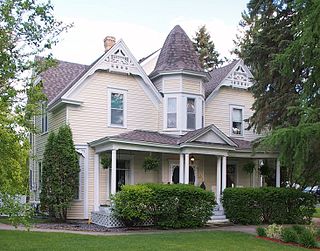
The H. G. Leathers House is a historic house in St. Francis, Minnesota, United States. It was originally built on a site near the Rum River around 1883. Around 1890 it was moved closer to the river and expanded. The property was listed on the National Register of Historic Places in 1979 for its local significance in the themes of architecture and commerce. It was nominated for its association with three generations of an influential local family, and for its status as one of Anoka County's few Victorian houses.




















